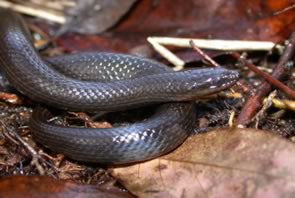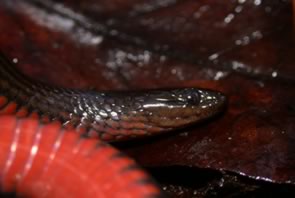
Seminatrix pygaea
Photo by JD Willson
Description: The black swamp snake is a small, shiny black snake with a bright red or reddish-orange belly. It has smooth scales and its head is not much wider than their neck.
Feeding/Diet: Black swamp snakes eat a variety of aquatic prey, including leeches, small fish, tadpoles, and salamander larvae.
Habitat/Range: Black swamp snakes are perhaps the most aquatic snake in North Carolina and are found in cypress ponds, swamps, Carolina bays, and other shallow water bodies with dense aquatic vegetation. These snakes are very secretive and rarely, if ever, bask in the sun. If they do leave the water, it is usually at night during heavy rains.
Reproduction: They give birth to 2–13 young between August and October, and the babies look like miniatures of the adults.
Miscellaneous: When captured, they may release musk from glands at the base of the tail, but they rarely bite in defense. Although these snakes can be very abundant in some habitats, they are rarely seen because of their secretive habits. Very little is known about this shy little snake, especially in North Carolina where no ecological studies have been conducted.

The shaded region represents the range of the black swamp snake in North Carolina.



A view of the intensely red belly of the Black Swamp Snake.
Photo
by JD Willson
Photo by JD Willson



This website created by: J. Willson, Y. Kornilev, W. Anderson, G. Connette and E. Eskew.
For comments or questions contact M. Dorcas: midorcas@davidson.edu.
M. Dorcas homepage: http://bio.davidson.edu/dorcas
Davidson College, Davidson, North Carolina 28035-1719.
Text and maps from: Dorcas, M. E. 2004. A Guide to the Snakes of North Carolina. Davidson College - Herpetology Laboratory, Davidson, NC. – Copyright by Michael E. Dorcas.
Partial Funding for this website provided by a Associate Colleges of the South, National Science Foundation, and Duke Energy.
